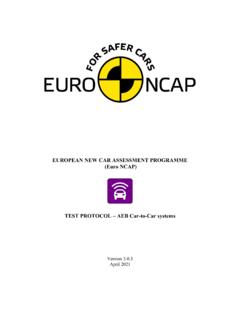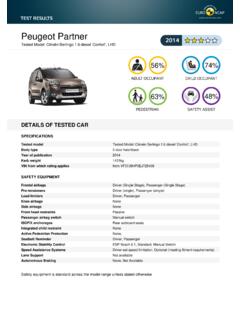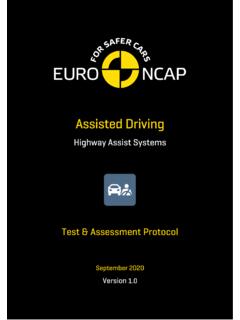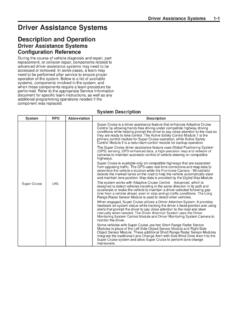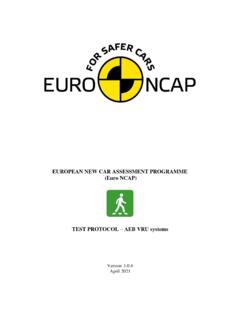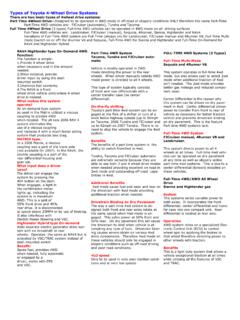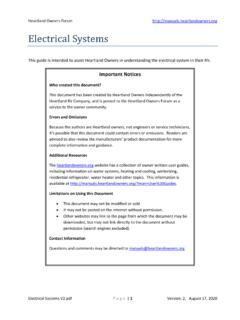Transcription of EUROPEAN NEW CAR ASSESSMENT PROGRAMME TEST …
1 EUROPEAN NEW CAR ASSESSMENT PROGRAMME (Euro NCAP) TEST PROTOCOL AEB/LSS VRU systems Version June 2021 Copyright 2021 Euro NCAP - This work is the intellectual property of Euro NCAP. Permission is granted for this material to be shared for non-commercial, educational purposes, provided that this copyright statement appears on the reproduced materials and notice is given that the copying is by permission of Euro NCAP. To disseminate otherwise or to republish requires written permission from Euro NCAP.
2 EUROPEAN NEW CAR ASSESSMENT PROGRAMME (Euro NCAP) TEST PROTOCOL AEB VRU SYSTEMS Table of Contents 1 INTRODUCTION .. 1 2 DEFINITIONS .. 2 3 REFERENCE system .. 5 Convention .. 5 Lateral Path 6 Profiles for impact speed 7 4 MEASURING 9 Measurements and Variables .. 9 Measuring Equipment .. 10 Data Filtering .. 10 5 EURO NCAP VRU TARGETS .. 11 Specification .. 11 6 TEST CONDITIONS .. 12 Test Track .. 12 Weather Conditions .. 13 Surroundings .. 13 VUT Preparation .. 14 7 TEST PROCEDURE.
3 16 VUT Pre-test Conditioning .. 16 Test Scenarios .. 17 Test Conduct .. 37 Test Execution .. 38 ANNEX A OBSTRUCTION DIMENSIONS .. 41 ANNEX B TESTING AT LOW AMBIENT LIGHTING CONDITIONS .. 42 ANNEX C BRAKE APPLICATION PROCEDURE .. 60 Version June 2021 1 1 INTRODUCTION Accidents between cars and vulnerable road users are one of the most frequent accidents happening on the roads due to driver distraction or misjudgement. Typical accidents between cars and vulnerable road users occur at city speeds where pedestrians and cyclists cross the path of the vehicle.
4 These types of accidents usually coincide with severe injuries and leave the driver with very little reaction time to apply the brakes. To support the driver in avoiding when possible or mitigating such crashes, car manufactures offer avoidance technology that reacts to the situation by autonomous braking and at higher speeds may issue warnings to alert the driver. Systems that specifically look for and react to vulnerable road users like pedestrians, cyclists and motorcyclists are called AEB/LSS VRU systems.
5 This protocol specifies the AEB/LSS VRU test procedure for Car-to-Pedestrian, Car-to-Bicyclist and Car-to-Motorcyclist scenarios, which are part of Vulnerable Road User protection. Note: Active Safety scoring in VRU is conditional to the total points achieved in subsystem tests, the sum of pedestrian Headform, Upper Legform & Lower Legform scores. If the subsystem total test score is lower than 18 points, no points are available for AEB/LSS VRU, regardless whether the system is fitted and would achieve a good score.
6 Version June 2021 2 2 DEFINITIONS Throughout this protocol the following terms are used: Peak braking Coefficient (PBC) the measure of tyre to road surface friction based on the maximum deceleration of a rolling tyre, measured using the American Society for Testing and Materials (ASTM) E1136-10 (2010) standard reference test tyre, in accordance with ASTM Method E 1337-90 (reapproved 1996), at a speed of , without water delivery. Alternatively, the method as specified in UNECE R13-H. Autonomous Emergency braking (AEB) braking that is applied automatically by the vehicle in response to the detection of a likely collision to reduce the vehicle speed and potentially avoid the collision.
7 Forward Collision Warning (FCW) an audiovisual warning that is provided automatically by the vehicle in response to the detection of a likely collision to alert the driver. Autonomous Emergency Steering (AES) steering that is applied automatically by the vehicle in response to the detection of a likely collision to steer the vehicle and potentially avoid the collision. Emergency Steering Support (ESS) a system that supports the driver steering input in response to the detection of a likely collision to alter the vehicle path and potentially avoid a collision.
8 Vehicle width the widest point of the vehicle ignoring the rear-view mirrors, side marker lamps, tyre pressure indicators, direction indicator lamps, position lamps, flexible mud-guards and the deflected part of the tyre side-walls immediately above the point of contact with the ground. Car-to-Pedestrian a collision between a vehicle and an adult or child pedestrian in its path, when no braking and/or steering action is applied. Car-to-Bicyclist a collision between a vehicle and an adult bicyclist in its path, when no braking and/or steering is applied.
9 Car-to-Bicyclist Dooring Adult (CBDA) a collision between the vehicle s door and a bicyclist traveling alongside the parked vehicle. Car-to-Motorcyclist a collision between a vehicle and a Motorcyclist in its path, when no braking and/or steering is applied. Version June 2021 3 Vehicle under test (VUT) means the vehicle tested according to this protocol with a pre-crash collision mitigation or avoidance system on board. Euro NCAP Pedestrian Target (EPTa) means the adult pedestrian target used in this protocol as specified in ISO 19206-2:2018 Euro NCAP Child Target (EPTc) means the child pedestrian target used in this protocol as specified in ISO 19206-2:2018 Euro NCAP Bicyclist Target (EBT) means the bicyclist and bike target used in this protocol as specified in ISO 19206-4.
10 2020 Euro NCAP Motorcyclist Target (EMT) means the Motorcyclist target used in this protocol as specified in the deliverable of the MUSE project (Fritz and Wimmer 2019) which at time of publication is to be replaced with ISO 19206-5. Time To Collision (TTC) means the remaining time before the VUT strikes the EPT, assuming that the VUT and EPT would continue to travel with the speed it is travelling. TAEB means the time where the AEB system activates. Activation time is determined by identifying the last data point where the filtered acceleration signal is below -1 m/s2, and then going back to the point in time where the acceleration first crossed m/s2 TFCW means the time where the audible warning of the FCW starts.
